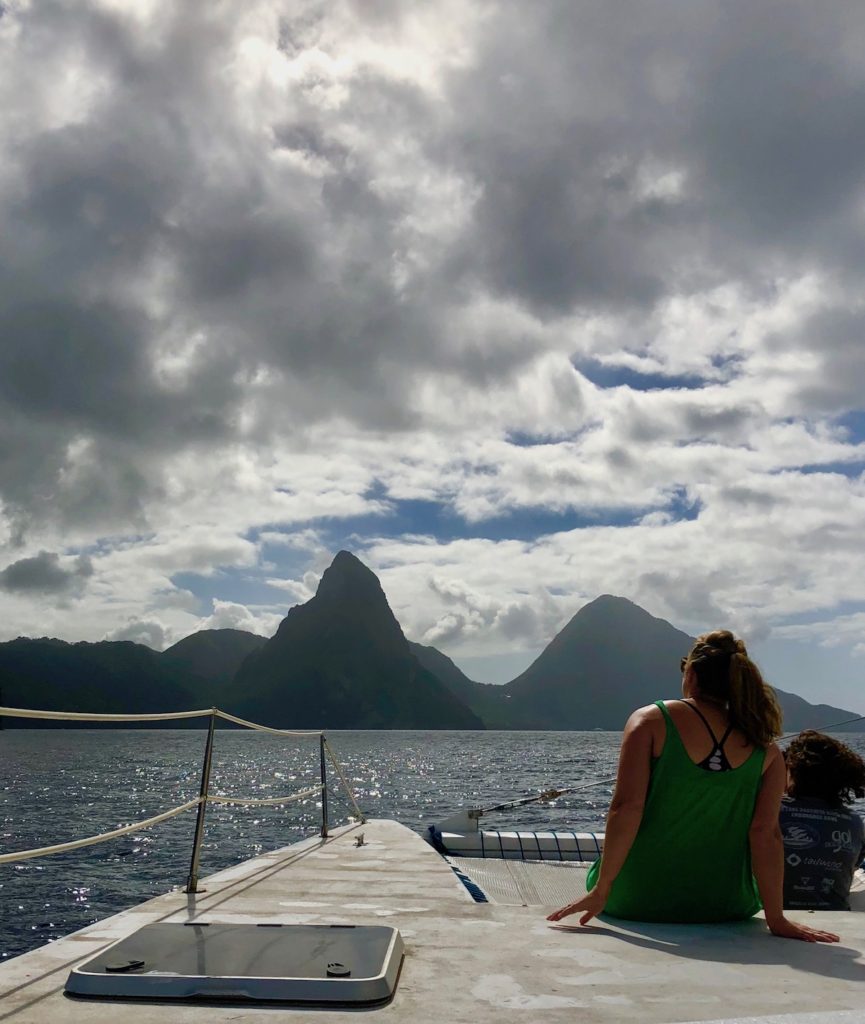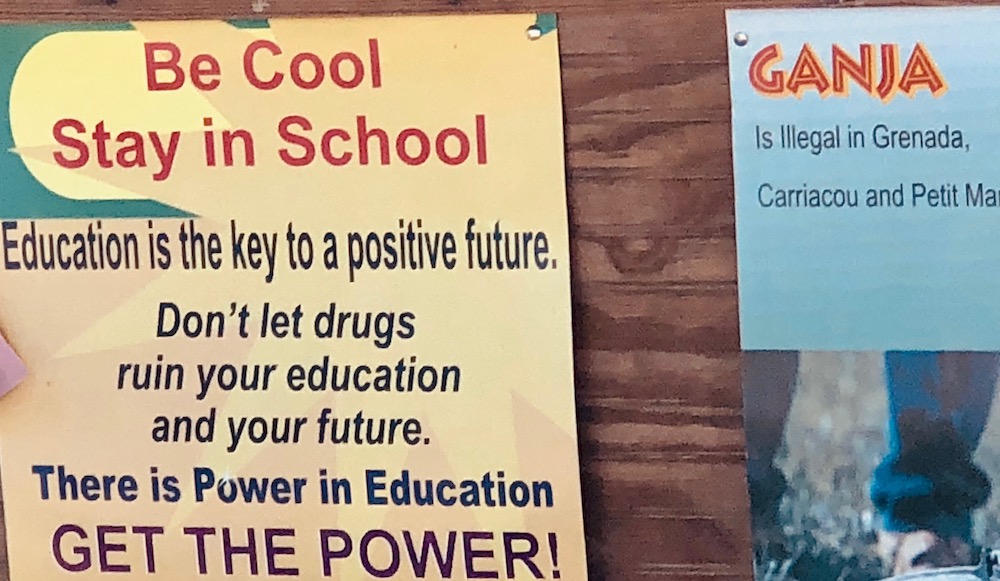
So which is it: An idyllic paradise, or the modern-day legacy of a colonial past? Is it a picturesque Old World British village set in a lush tropical paradise, or the former site of bloody revolution, executions, and brutal slavery? Is it a romantic Loveboat, or the place where relationships go to die?
That old saying ‘there are two sides to every story and the truth is somewhere in the middle’ applies to our Caribbean trip so far. Take that last contrast, for instance, on full display in the ship elevator the other day.

When the door shut after an elderly couple got off, another passenger asked the rest of us, “Did you hear what she said?” Turns out she was sharply reprimanding her hubby – he should treat her better since she’s been his lover forever. The rest of us chimed in with other stories of overheard squabbles – about money, tours, and yes, geriatric sex – all over ship and shore.
We’ve been underway a week now and inevitably, the initial glow of idyllic cruise life wears off and people return to their land-based selves. Squabbling couples still squabble, happy couples dance off the elevators, rude people are still rude, nice people are still nice. It’s a floating city, after all, with strata of residents from the pampered suites guests to dining servers residing in tiny cabins down below.

A cruise ship can be a tough place for relationships: You’re cloistered in a small space 24-7, negotiating plans for excursions, meals, entertainment possibilities – if all that’s rocky at home, it’s rocky here as well, even with room service and the premium drink package (maybe because of the drink package?). But the elevator social commentators agreed: No time for grumbling here in paradise, as we laughed and headed off to find more fun in the sun.
Earlier at the 5:00 am coffee station I met one of the nice types, a lovely Frenchwoman from Quebec (morning people are usually nice – or annoyingly perky, according to night people). When I gestured for her to go first since I had a thermos, she smiled and said in halting English, “thumpa thumpa” indicating that all that coffee would make my heart race (true, that). Turns out she’s married to an American who only speaks French two days a week so she’ll practice her English more. She obviously wanted to practice, so we ‘chatted’ – lots of hand motions on my part, since my only French words are parley-vous angalis s’il vous plait (Parisians appreciated my efforts to say that and didn’t shun me, even though I’m sure it was wretched French coming out of my mouth).

So on the island of St. Lucia, we sailed off to the ‘idyllic paradise’ side of the Caribbean after we walked off our cruise ship in Castries Harbor and onto the catamaran El Tigre for a private charter arranged by another cruise critic roll call member. Soon after the crew hoisted the sails, Captain Jonathan pointed ahead over the ocean swells to pilot whales and dolphin pods, just off the port bow.

Do they use radar to locate the critters, like we do in the Pacific Northwest? Nope –sight only – look for spouting and splashing. We saw plenty of that and more, as we sailed straight into two dolphin pods – the graceful creatures swam close to, under, and in between the hulls of El Tigre. Wow! Pilot whales stayed farther out but showed off their leaping and spouting, to the delight of all of us.

And now to the not-so-idyllic side: We learned about St. Lucia’s (and Grenada’s) banana problem from one of the crew. Several years ago, St. Lucian farmers enjoyed making what to this day is remembered as “green gold” – lucrative banana farming profits that lifted many poor farmers out of poverty and into the middle class. Old banana farmers still remember the days when they could buy new homes or afford their children’s college tuition, with all the ‘green gold’ they made supplying the European market. That ended when multinational companies like Chiquita and Dole muscled out small Caribbean farmers by successfully lobbying American politicians to quash Eurozone protections.
It’s likely there would have been plenty of banana market for everyone even with the protections in place, but many suspect that plain old greed was the culprit here. Makes sense to me, since economic giants tend to force out the little guys (I’m talking about you, Walmart…). Today, former banana farmers scrape by serving the tourist industry, with green gold only a distant memory.

Reliance on one export is always a gamble, but depending on behemouth cruise ships that dump entire cities of people at the dock for the day looks dicey as well. What happens to a small island’s economy if the cruise industry tanks? Or a hurricane wipes out a port? Today, the tourist industry serves as an economic lifeline to the islands, but it’s still a precarious situation.
But no wonder so many tourists from all over the world come here – there’s a reason the islands have served as an idyllic paradise for luxury, relaxation, consumption and exploitation (think shopping, sugar cane, and slavery – more on all that in future posts).

It would take a lot of green gold – more than we have, for sure – to afford the nightly prices at some of the Architectural Digest-worthy residences and resorts we sailed past all along St Lucia’s coastline. We also cruised around Marigot Bay, one of the prettiest harbors in the Caribbean, where parts of the 1960s Dr. Doolittle movie were filmed – this little kid adored Dr. Doolittle, so I really appreciated that piece of trivia. Padre tried to interest me in a discussion of the fluid dynamics of water (for some reason he loves to read books like Physics in 5 Minutes – go figure) but I ignored him as I stared up at clouds drifting past as I lay on my back on the catamaran netting. Ah.

After El Tigre’s crew picked up supplies on the docks of the lovely seaside village of Soufriere, I ssnorkeled at Anse Chastanet, in calm, cobalt-blue waters over a reef teeming with tropical fish. Padre chatted with other passengers, soaking in the views of the iconic Pitons, volcanic peaks that dominate St. Lucia’s scenery. (Rough life that Padre lives, especially with those cotton breezes wafting past; how does he stand it?).


Later after we said goodbye to our crew and walking a few yards back to our ship home, we decided that a future visit to St. Lucia – by land next time – was in the offing, since its enticingly lush rain forest looked so inviting. Padre also left St. Lucia with his very own Mystic Man* crew t-shirt: sort of clergy-like in a Baptist-Buddha type way, and also very Padre. (*the name of the tour company that owns El Tigre).
Too bad there aren’t more bananas, though.

We toured Grenada’s lovely capitol, St. George, the next day. Set on a perfect bay, St. George’s handsome buildings climb up the bourganvilla-covered hills to the imposing, cannon-guarded Ft. George, perched on its highest hill. One version of Grenada – the charming British-era one – is balanced by the history of the fort, where we revisited the 1983 bloody coup and US intervention from a Grenadan’s perspective.
I remember the 1983 American version of this story – The U.S. intervened to overthrow a coup by revolutionaries. I appreciated how our guide framed his retelling, though; he hesitated as he described U.S. efforts to help out:
An intervention?
An invasion?
or maybe an intrusion?
Then left it to us to decide for ourselves which one we thought it was. Of course, it all depends on how you look at it, doesn’t it?

The facts indicate it may have been all three, and politics, of course, played a part. (But how typically American, the name of the military effort: Operation Urgent Fury.)
What the Grenadan military junta did to Maurice Bishop, a pregnant woman, and a total of eight government leaders in all – was horrendous: They lined them up in front of a brick wall, where we could still see the bullet holes, and shot them in cold blood. Nothing makes that ok – certainly not a plain old power grab due to internal power struggles. I grimaced at the morbidly ironic “No pain, no gain” graffiti, considering how those people died, and for what?

Six days after Bishop’s death, US President Ronald Reagan launched a successful invasion, citing the safety of 600 US medical students who weren’t in any danger as justification for his actions. He was internationally condemned by countries around the world, who saw the US actions as a violation of international law. Democratic elections began again in 1984, and today, Grenadans celebrate the date of the invasion as a national holiday. So the whole debacle sorted itself out eventually, but Ft. George’s cannons aiming down at our cruise ship suggest that war is hell, no matter what you call it.

We returned soon enough to the idyllic side of Grenada after our fort visit: another exquisite beach for snorkeling and sunning. I mean, is there any other kind of beach here in the Caribbean? We batted beach vendors away, until I finally succumbed to Jennie the craft lady, who had been selling hand-sewn decorative dolls on this beach for 20 years. And one of the grandchildren’s names showed up in the sand – how’d that get there? After our skin reached that nicely broiled crispy stage, we couldn’t leave Granada the Spice Island without purchasing some of its best stuff back at the port’s tourist kiosks. I found a large packet of saffron for a measly $4, and Christmas baking spices like nutmeg and cloves. But we also found the Marley Shop.


Back home in Washington State where marijuana is legal, we’d call this place a Pot Shop, Green Shop – or the older people lingo for it, a Medicinal Marijuana place. But ganja is not legal in Grenada, and seems to be a problem for its youth – check out the sign on a local community center (next to my fave sign about school – yay school!). So this place only sold paraphernalia like glass pipes – and Marley stuff like these earrings. Poor Marley, he’s commercialized everywhere in the Caribbean (what I know about him tells me he’d think it quite the hoot, old ladies off to cruise ship dinners with his face dangling from their ears).

Back at the dock, we waved goodbye to passengers next door on the other behemouth cruise ship in port today, the MSC Preziosa. And everyone waves goodbye to all those tourist dollars they left back there in Grenada’s shops. While Grenada is unique in that it also has the spice trade to rev their island economy, I’m sure all that cruise passenger green gold helps keep things humming along.

So tomorrow, the island of Aruba. Will it be the idyllic honeymoon resort enclave advertised in all the travel commercials? Or will there be more to the story, behind all those pretty pictures? We hear there may be pirates afoot, as well as plenty of thrilling alternative scenery once we venture away from the predictable resort-side of the island. We hope to discover both sides of Aruba’s story in our two days there, so stayed tuned, and thanks for following along!

